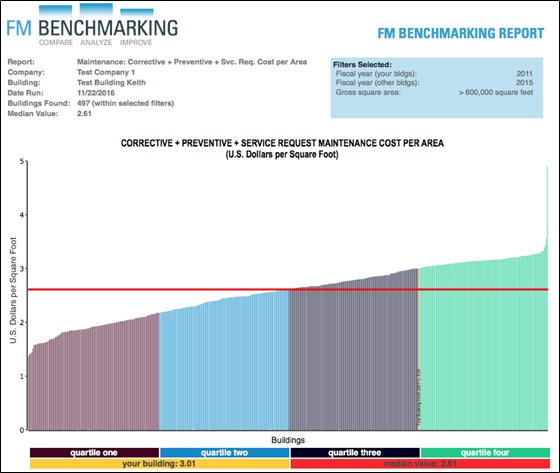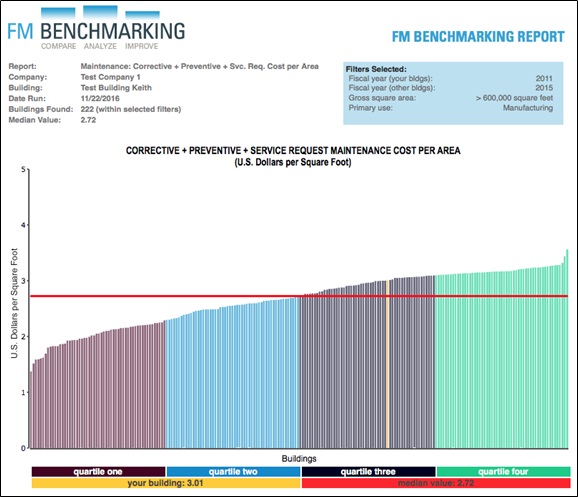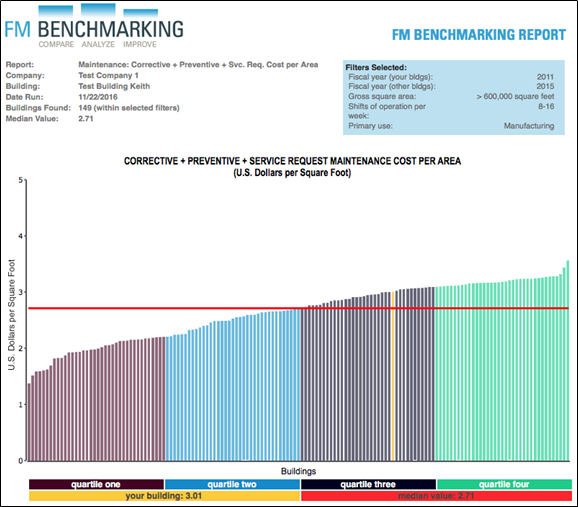November 2016 — One reason FMs join benchmarking programs is to see where they stand in comparison to their peers. But to obtain useful benchmarking results you need comparisons of similar buildings using filters to select the characteristics of the facility you want to compare. Select the wrong filters and your comparisons will be off and unusable.
Let’s look at a few examples to see the value that filters can bring to the analysis. In this example our facility is a 1,325,000 gross square foot (GSF) facility, first occupied in 2010, with 3,044 FTEs (full time equivalents) with a primary business function of manufacturing; it is located in a suburban location.
The first filter we will turn on is the size of the facility so that we will only consider buildings that are 600,000 GSF or greater. In the FM BENCHMARKING database, which we are using for this discussion, this produces 497 facilities for comparison. To track the performance of our peer group, we need to note the median value; in this case it is $2.61 per GSF. In Figure 1, our maintenance cost is shown by the yellow bar as $3.01 per GSF, which indicates a performance just at the break between the third and fourth quartile.
Figure 1. Maintenance Cost per Area
Filters: >600,000 GSF
Provided courtesy of FM BENCHMARKING
However, just using the size filter is not a good comparison of our building performance. Maintenance costs should be impacted by the type of facility, in this case manufacturing. We should compare our performance with other peers in the manufacturing industry. We now turn on the filters:
- Gross square area: 600,000 and greater Square Feet
- Manufacturing
Note that while our maintenance cost is still $3.01 per GSF, our peer group median performance is more expensive at $2.72 per GSF (instead of $2.61 per GSF) – see Figure 2. The prior chart did not filter for types of facilities; as a result, it included offices and other types of facilities that are less expensive to operate. Maintenance costs for a manufacturing facility are expected to be higher than for office buildings. Comparing our performance with other manufacturing type facilities puts our maintenance costs near the middle of the third quartile instead of at the start of the fourth quartile.
Figure 2. Maintenance Cost per Area
Filters: >600,000 GSF and Manufacturing Only
Provided courtesy of FM BENCHMARKING
The manufacturing facility operates three shifts a day, five days a week. Is that a factor in the benchmarking analysis? To analyze this we will turn on the filters for:
- Gross square area: 600,000 and greater Square Feet
- Manufacturing
- Three shifts per day, five days per week.
Our peer group median maintenance performance hardly changes at all from $2.72 to $2.71 per GSF. This isn’t really a surprise since most manufacturing facilities operate for extended shifts (see Figure 3).
Figure 3. Maintenance Cost per Area
Filters: >600,000 GSF, Manufacturing Only, 3 shifts per day for 5 days per week
Provided courtesy of FM BENCHMARKING
As you can see, there are some significant changes in our ranking position that are made simply by better peer group comparisons from applying filters. A true peer group comparison shows our facility near the middle of the 3rd quartile. That isn’t a great position and indicates a need for additional analysis to see why our costs are so high.
To reduce our maintenance costs, the next step in the process would be to see which Best Practices are being employed by the buildings that our to the left of ours in the chart. We then can see what we may do differently in our facility. We’ll present more on this in next month’s article.
In conclusion you can see how the application of filters can impact your relative rankings in a very significant way. This allows for comparisons to a more similar peer group and is a much more effective way of using benchmarking tools.


